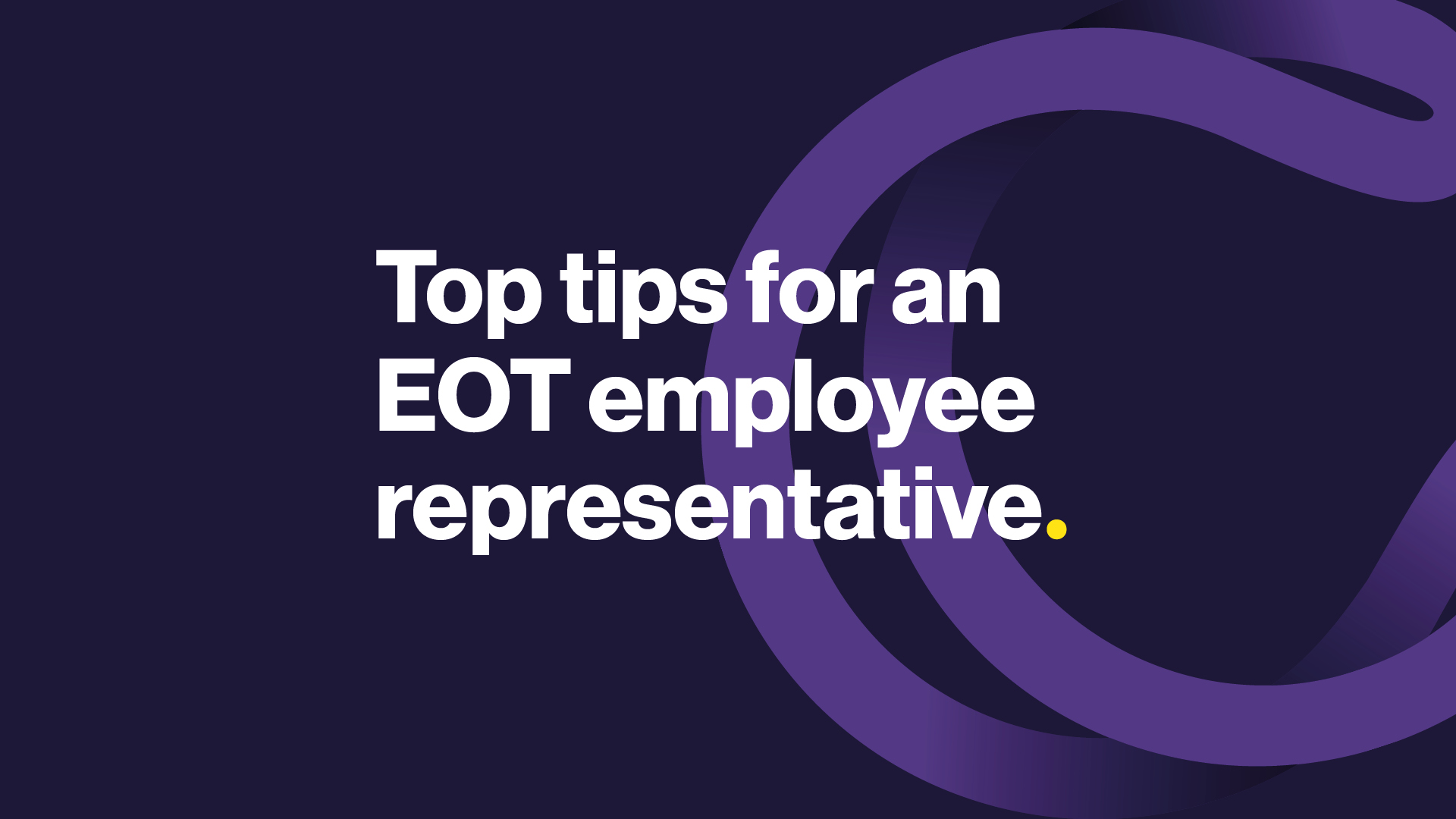Putting your name forward to become an employee representative of an Employee Owned Trust (EOT) can be a daunting prospect. You may have lots of questions before considering whether it is right for you. After two and half years as our employee representative, Kelly Dronsfield, shares her insights and top tips about the role.
One size does not fit all
Having attended quite a few on and offline courses and webinars, the one thing that stood out for me is the difference between being part of a large employee-owned company and a small one. Communicating the initial sale right through to engaging employees on important matters has a completely different dynamic depending on your business. You must consider the existing organisational structures, and engagement platforms you have available and be realistic about what is achievable for your company. For instance, is there a feedback mechanism you can add to your intranet? Or if you have regular internal meetings, could you add an agenda item for employee feedback? A large company might use apps to increase engagement but where the scale is smaller, meetings and open forums might be more effective.
Set out a blueprint
Once the EOT sale is completed, and the Trust Deed is in place, there are so many things to consider. As a member of the EOT Board, you’ll help set out a blueprint of what employee ownership will look like. For example, how does it align with your company’s current vision and values; what is the leadership exit plan and how will it impact the business at all levels; what amount of transparency can you share around critical decision-making; what should your expectations be of the employees you represent; if not already in place, how to form and distinguish between an Operational Board that will move the business forward and the EOT Board that will provide governance; and, of course, timings to accompany each milestone.
Engage. Consult. Repeat
Employee engagement as part of an EOT is not linear. What I thought would make for good engagement and understanding has changed quite a bit in my two years, and what works at the start will not always be the case in the future. As an employee representative you need to be prepared to link in with your Internal Comms teams to scrutinise what is in place, how it is being engaged with and how it can be improved. You must also be flexible in your approach and adapt to what works in that moment. After the initial announcement, we added an FAQ and Q+A section to our intranet. However, the engagement was quite low, and when we did get questions, they were more operational in nature. So be prepared to change what you’re doing and consult with your team more.
The sound of silence
This leads me on to addressing what to do when you ask for feedback, and no one has anything to add. Just because no one is saying anything doesn’t mean there aren’t areas for improvement. Part of the role is being able to dig a bit deeper and draw out the less confident voices to reach the little nuggets of wisdom and scrutiny. Having a strong culture can help facilitate healthy disagreement, to make sure you arrive at the right solution.
How much is too much?
In the most part, the information that is shared with beneficiaries is likely to be different in each company. However, it helps if employees understand the level of transparency your business is prepared to share.
We wanted employees to act like beneficiaries, so we felt they needed to know what the long-term business goals were. Whilst we don’t detail specifics on overheads, staff are informed of monthly gross profit, whether this is in line with our forecast and they are encouraged to be proactive in ensuring targets are met. They are also kept aware of any deficit or surplus position, so they understand the impact on business planning, operations and the future.
Employee representatives may need to be more closely involved in certain financial decisions, so they can feed back appropriate information to the wider team. This could include details pertaining to the Profit Share Bonus and whether the business is able to pay one out in that financial year. Dependent on the terms of your Trust Deed, there may be instances where financial decisions require input from the employee representative, for example agreement on senior level recruitment, redundancy or a change in the direction of the business. These provisions can be different for every company, but where governance is concerned, you must refer to your deed if you are unsure.
Since we became an EOT, we have encouraged beneficiaries to suggest ways to improve the employee experience and have introduced flexible working and increased employer pension contributions, as part of giving staff a voice and more autonomy. Whilst this should always be encouraged, the employee representative has to wear two hats – ensuring they’re representing the employees best interests whilst being realistic and transparent about how any additional financial benefit might impact business performance, and ultimately company profits.
Coaching and delegation
Having a good idea and knowing what to do with it are two very different things. Sometimes there is confusion over the employee representative role in that they are the person to take every idea to the EOT board, or they are the person to make things happen, but this isn’t the case. In reality, most ideas are operational ones that the team can drive forward themselves in collaboration with the leadership team or Operational Board. But not everyone is skilled in this way. This is where coaching and playing to your teams’ strengths is so important. If you are frustrated with an abundance of ideas but a lack of delivery, think about what you can do to address it. It might be that a clearer process could be put in place, some upskilling or simply encouraging more cross-departmental collaboration. For example, if someone comes forward with an idea, sit down with them, provide guidance, and discuss what it would take for it to happen – what would the costs be? what internal resource would you need? Is it an operational idea or one that would need to be considered by the EOT Board? Does anyone else internally need to be part of the discussion? And, crucially, does it fit with what you’re are trying to achieve as a business?
Everyone needs support
Whilst EOT’s have been around for some time, significantly more companies moving to this model is a relatively recent development. So, I found that once the initial sale went through, there was very little support or guidance, particularly for small businesses, or for the exiting leadership team. Whilst, I appreciate every business is different, with no precedent set or roadmap to follow, you can often feel on a backfoot in terms of what you should be communicating. Being part of an EOT is a journey all employees of the business go on together, with the understanding that it’s a learning curve, so no one person or group has all the answers. In addition, when the time comes for the exiting director to take a back seat, they need support and understanding. The business may have been their mainstay for a long time – for original owners, it may still feel like their baby. They’ll need to be confident that the employees have the passion and commitment to continue driving the business forward and are ready and able to take on the challenge of maintaining a profitable and successful company, year in, year out. At C21, we’ve tried to ensure that each member of the team understands how they make a positive impact through their day-to-day role and how that, in turn, affects the success of the business. Not every employee may be client facing but, as part of an EOT we recognise that we all have an equal part to play in ensuring we deliver high quality, insightful, well executed creative campaigns – on time and on budget.
‘Dress for the role’
If, like me, there is some cross-over with your operational role, think how you can tangibly separate the two roles. In my case, I work in internal comms and traffic management which is quite a central role in the business. I do dress-down most days but, much to everyone’s amusement, when we have an EOT meeting, I tend to dress more formally. This is done for my own benefit but also to signpost to other employees that I’m wearing a different ‘hat’ that day. I was reassured at a recent EOA event when someone said their Board do that exact same thing. It is only subtle, but it is another way to separate your operational role.
This is, by no means, an exhaustive list and if you’re an employee representative too, you might be able to add to it or provide alternative approaches to some of the points raised – I have, no doubt, every experience will be unique. However, if you’re new to the employee rep role or putting yourself forward, I hope this is gives you some insight and food for thought.



